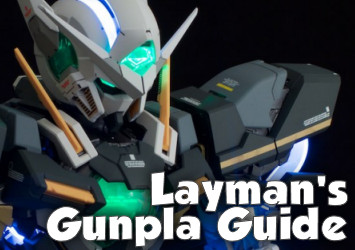I wanna have a pure time. Everyone's a noble mind.
There's no doubt that I'm a fan of the Gundam franchise. For years, I've watched the programs, collected the DVDs, downloaded the pictures, read the notes, and pieced together the models (though, poorly). I've immersed myself in the world of giant robots, angst-ridden teen pilots, colony drops, and downer endings for quite a while now. I have definite opinions on mechanical designs, plotlines, and alternate continuities. I'd like to think that most of them are well-informed by my experiences in Gundam fandom.
So, it's no wonder that I'm particularly passionate about my favorite Gundam production, the well-recieved sequel to the original 1979 series, Mobile Suit Zeta Gundam. In fact, it's the most consistantly popular Gundam television series, only slightly behind more recent efforts in the past few years (any of which I doubt will hold up as well). Only a show this popular could garner a massive audience when remade into a movie trilogy twenty years after broadcast (the quality of the movies, however, were not worth the effort, as I'll explain later). Certainly my love for this series can't simply be due to its popularity though, can it? Of course not.
It's because it's the best damn mecha anime of all time.
The series begins seven years after the end of the previous one, in the same place, the "Side 7" group of space colonies. Where there was once only one colony, there are now two, Green Noa 1 and 2. Green Noa 2 is where the Federation's elite taskforce, a group of hand-picked Earth elite fascists called the Titans, are headquartered. Green Noa 1 is presumably the same colony that had been virtually destroyed in the beginning of the original series. If so, the colony that had once been the home of Amuro Ray is now the home of the new main protagonist, Kamille Bidan. He gets swept up in the battle between the Anti-Earth Union Group (AEUG) and the Titans and becomes the pilot of a stolen Gundam Mk II and eventually the titular Zeta Gundam, which he helped to design himself.
There are several returning faces in the battle between the corrupt Federation and the rebel faction. One is a thinly disguised Char Aznable, who goes under a new moniker, "Quattro Bajeena" and serves as the lead pilot for the AEUG's flagship, the Argama. Another is Bright Noa, once the captain of the White Base, who returns and defects to the AEUG, becoming captain of the Argama. Amuro Ray also returns, along with Hayato Kobayashi, both members of the Earth-based Karaba resistance group. In fact, most of the original cast at least cameo. Katz, one of the trio of orphan brats who called the White Base home becomes a pilot for the AEUG as well, though doesn't fare all that well. However, most of them remain secondary characters at best, never crossing the line and stealing the limelight from the new cast (unlike a certain other Gundam sequel series I can name). Some of them even have slightly different dynamics.
The structure is a lot more complex than the original show's. In the original, the story began in space, went to Earth, then returned to space for the final third. In Zeta Gundam, they're back and forth from space to Earth, but likewise, the finale is in space. Typically, there's a plan formed, a battle is fought, then the battle is either won or lost, but the formula doesn't remain constant. What's interesting is that the protagonists lose their fair share of battles, too, and even some of their wins don't look like victories at all.
Whereas the original had the Earth Federation fending off the fascist Principality of Zeon, run by the devious Zabi family, Zeta Gundam instead has the rebel AEUG fighting for control of the Federation with the Federation's elite Titans taskforce. Now, mind you, the Titans commanders aren't the most nuanced villians, most of them being cackling maniacs who just seem overly eager to kill off civillians in order to look big. However, the premise of the Titans is interesting. They were the result of the previous series, born from the Federation government's fear of the people living in space and their indifference over whether the civilians were mistreated if it meant calming their worries. That these power-hungry bullies, the Titans, are so easily able to push around civilians comes into being because of the Earth Federation's fear of spacenoids gives the show a layer of complexity the original did not have. Add to that their dismay over the tactics of the Titans when they themselves, the government officials, were threatened in an battle between the AEUG and the Titans in their capital when the rebels just wanted to be heard in council.
I find a lot of interesting moments coming from the reactions from the people in charge in the colonies, too. For instance, a mayor of one Side (group of colonies) decides to surrender to the Titans even though he was supposed to work with the AEUG, and when a smarter man working a communications computer reaches out to the AEUG instead, the mayor has him shot. The Titans, however, aren't willing to negotiate, because they're there to destroy the colony as a show of power, so when the AEUG manages to save them, the mayor convinces the worker to not tell anyone of what happened. Furthermore, he tells the AEUG that the man with the sling was injured subduing a traitor who tried to side with the Titans. To show what sort of extreme situations come out of this conflict and the lengths government officials will go is already well beyond the scope of the original series.
The AEUG and their Earth-based equivalent, the Karaba, are another interesting couple of groups. The AEUG are made of both Federation officers who are fed up with the Titans' tyranny and former members of the Zeon who still dislike the Federation government. But there's two hands to the group, and the Earth-based Karaba seem to be doing their own thing at times, but then join up with the AEUG when necessary, coordinating in the attack on Jaburo, Kilimanjaro, and Dakar. Karaba provides a story outlet for characters like Amuro and Hayato from the original series, allowing them to appear and be heroic, but without outshining the characters of this series. The AEUG, meanwhile, are largely supported in space by Anaheim Electronics on the moon, who also supplies the Titans and whose corporate directives often rub the frontline commanders the wrong way. This is embodied by a character named Wong Lee, a representative from Anaheim who barks orders, lectures, naysays, and indiscriminately hits Kamille in order to "correct" his often erratic behavior. Though his approach to the conflict may indeed show some positive results, he's clearly irritating to captain and mobile suit pilot alike. He does have his "pet the dog" moments, though.
Likewise, the Titans have their share of folks, who, while still pretty amoral, aren't just your stock bad guys. Most of them are just jockeying for some sort of higher position and are using the Titans to do so. And some of them are even naive enough to believe that what the Titans are doing is a necessary evil to protect the planet from threats from above. Granted, there could have been more of these, but their inclusion at all makes it a little more balanced than the original Mobile Suit Gundam. Not to mention that some of these characters can be sympathized by the viewer. Jerid, for instance, is predominately just a very unlucky (or very lucky, depending on your point of view) guy who lets his rivalry with Kamille get the better of him to the point where it's all consuming. Sure, he showed that he was a cocky jackass who didn't hesitate to shoot a fellow officer if he was in his way, but he had moments were he was genuinely supportive of his fellow teammates, even vowing to avenge the ones he was the closest to. Emma becomes so sickened by the tactics of the Titans' commanders, she defects to the AEUG a short time into the series.
As if two parties weren't enough in this conflict, a third comes into play in the second half of the program, a small group of Zeon soldiers who escaped to the asteroid Axis, who've lived outside the convenient reach of the Federation for several years and who've returned in order to coordinate with the efforts of Char, only to find him unwilling to work with them. The Axis Zeon are officially led by the daughter of Zeon admiral Dozle Zabi from the original series, Mineva. However, she serves only as a puppet for Haman Karn, a shrewd and manipulative young woman who had a past romance with Char and seems particularly bitter about his abandonment. I guess once you go red, you can't go... uh... to bed? Once you go red, you want him dead. Is Char that bad or that good? Reccoa Londe defects from the AEUG to the Titans because of his neglect of her. I think Tomino's point is, hell hath no fury like a woman scorned. Haman really seems to be a "magnificent bastard" type who always seems two or three steps ahead, and so the battle between the AEUG and the Titans becomes more complicated as both of those teams vie for the support of Axis.
There's a lot to cover when discussing this program. It's vast and has epic proportions. So I'll wrap up this first part in the tribute by asking you: do you believe in the sign of Zeta? Next time I'll get into the main protagonist, Kamille Bidan, and the unique mobile suit designs in the series. I may even get into the antagonists and the themes.
Believe in a sign of Zeta!

Mobile Suit Zeta Gundam Tribute - Part One: Believing A Sign of Zeta
Copyright 2020 - All Rights Reserved
Designed by: Flash Web Center LLC






